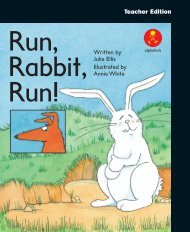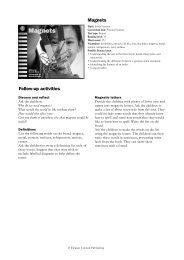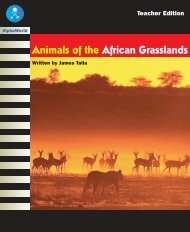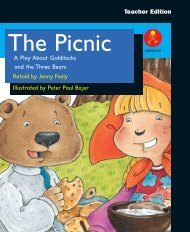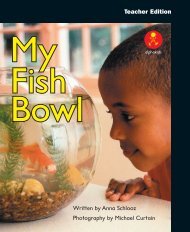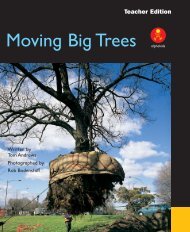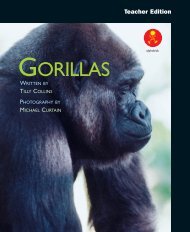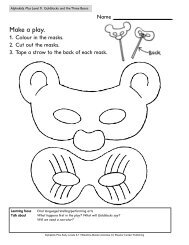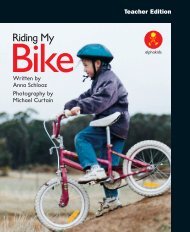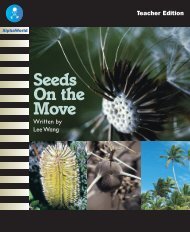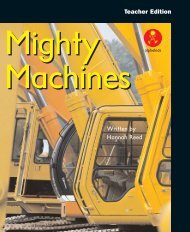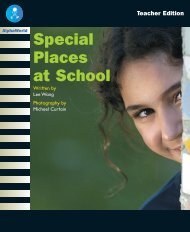L20 TE Saving the Rainforests
L20 TE Saving the Rainforests
L20 TE Saving the Rainforests
Create successful ePaper yourself
Turn your PDF publications into a flip-book with our unique Google optimized e-Paper software.
Teacher EditionAlphaWorld<strong>Saving</strong><strong>the</strong><strong>Rainforests</strong>Written by Tess Schembri
Horwitz EducationA Division of HorwitzPublications Pty Ltd55 Chandos StreetSt Leonards NSW 2065AustraliaHorwitz Gardner Limited168e High StreetEgham, SurreyTW20 9HPUnited KingdomPublished edition© Eleanor CurtainPublishing 2005Text © Nicole di MarcoPhotographs © EleanorCurtain PublishingFirst published 2005Apart from any fair dealing for<strong>the</strong> purposes of study, research,criticism or review, aspermitted under <strong>the</strong> CopyrightAct of Australia, no part of thisbook may be reproduced byany process, or transmitted inany form, without permissionof <strong>the</strong> copyright owner. Wherecopies of part or <strong>the</strong> whole ofthis book are made under PartVB of <strong>the</strong> Copyright Act, <strong>the</strong>law requires that records ofsuch copying be kept and <strong>the</strong>copyright owner is entitled toclaim payment.Developed byEleanor Curtain PublishingText: Nicole di MarcoConsultant: Susan HillDesigned byAlexander StittProduction byPublishing SolutionsPrinted in ChinaISBN 0 7253 3119 41 2 3 4 5 6 7 8 905 06 07How to use this bookThe AlphaWorld teacher editionssupport teachers as <strong>the</strong>y guidechildren’s reading and thinkingduring one or more guided readingsessions. Teachers can observechildren as <strong>the</strong>y read and choosefrom <strong>the</strong> given suggestions to suitindividual needs.Before readingSetting <strong>the</strong> context, front coverand title page:The suggestions help teachers to set<strong>the</strong> scene and prepare children forreading <strong>the</strong> book. Prompts help todetermine children’s priorknowledge. Where necessary,background information isprovided. Teachers are encouragedto check that children understand<strong>the</strong> vocabulary listed and to discuss<strong>the</strong> meanings and/or <strong>the</strong> structuresof <strong>the</strong>se words. Previousexperiences with similar text typesmay also be discussed.During readingPredict, Read, Reflect:Questions encourage children toengage with <strong>the</strong> text by makingpredictions. The children <strong>the</strong>n reada section of <strong>the</strong> text and reflect onwhat <strong>the</strong>y have read. The focus ison <strong>the</strong> content, language and textfeatures of <strong>the</strong> book.Observe and support:Prompts help teachers to focus on<strong>the</strong> strategies children use as <strong>the</strong>yread. Teachers can <strong>the</strong>n select fromand adapt <strong>the</strong> suggestions accordingto <strong>the</strong> needs of <strong>the</strong> individual child.The suggestions aim to develop achild’s reading abilities.Interruptions to <strong>the</strong> child’s readingshould be minimal.After readingA selection of reading andwriting activities:The last pages of <strong>the</strong> teacher editionprovide follow-up activities andinclude <strong>the</strong> assessment focus.Selected text features• Introduction and conclusion• Colour photographs support <strong>the</strong> text• Map of <strong>the</strong> worldVocabularyatmosphere, carbon dioxide, destroyed,erosion, habitat, malaria, medicines, metals,mine, pollinate, polluted, rainforests, rely,temperature, timber, valuable, wea<strong>the</strong>r
Setting <strong>the</strong> contextWhat is a rainforest? What do you knowabout rainforests?Record <strong>the</strong> children’s ideas on a chartfor future reference.Background informationTropical rainforests are amazing places.Many people, animals and plants needrainforests to survive. However,rainforests are endangered. People havedestroyed more than half of <strong>the</strong> world’srainforests in <strong>the</strong> last 60 years.<strong>Rainforests</strong> cannot be replaced. We mustact now to save <strong>the</strong>m.Front coverShow <strong>the</strong> front cover.This book is called <strong>Saving</strong> <strong>the</strong> <strong>Rainforests</strong>.What might that mean?What can you see on <strong>the</strong> front cover?Does this picture help you work out what<strong>the</strong> book is about?This book will help us to understand whyrainforests are important and how animals,plants and people need rainforests.Title pageTurn to <strong>the</strong> title page.What can you see in <strong>the</strong> photo?Is this what you thought a rainforest wouldlook like?
<strong>Saving</strong> <strong>the</strong> <strong>Rainforests</strong> Pages 2–5PredictDiscuss <strong>the</strong> contents page and read through <strong>the</strong>headings.Is this <strong>the</strong> type of information you expected to find? Why orwhy not?Turn to page 6.This is <strong>the</strong> introduction. The introduction tells us what <strong>the</strong>book is about. It says that many people, animals and plantsneed rainforests to survive but that tropical rainforests areendangered.Have you heard <strong>the</strong> word ‘endangered’ before? What doesit mean?Read to <strong>the</strong> end of page 5.ReflectWhat does <strong>the</strong> author think about rainforests?Why does she believe that <strong>the</strong>y are amazing places?Observe and supportCan <strong>the</strong> children explain <strong>the</strong> purpose of anintroduction?Why is this called an introduction? What does it tell us?2
<strong>Saving</strong> <strong>the</strong> <strong>Rainforests</strong> Pages 6–9PredictPeople are destroying rainforests in lots of ways. They clear<strong>the</strong> land to make room for farms, roads and houses. Theycut down trees for timber. They build mines that pollute <strong>the</strong>land and water.Look closely at <strong>the</strong> mining photo. What can you see? Wouldrainforest plants be able to grow near <strong>the</strong> mine?Turn to pages 8 and 9.For thousands of years, small groups of people have lived inrainforests without destroying <strong>the</strong>m. What would <strong>the</strong>sepeople know about rainforests? What will happen to <strong>the</strong>sepeople if <strong>the</strong>ir rainforest homes are destroyed?Read to <strong>the</strong> end of page 9.ReflectWhy are people destroying rainforests?How would <strong>the</strong> people who live in rainforests feel about thisdestruction?Observe and supportCan <strong>the</strong> child understand <strong>the</strong> text at a literal level?Why are some people able to live in <strong>the</strong> rainforestswithout destroying <strong>the</strong>m?4
<strong>Saving</strong> <strong>the</strong> <strong>Rainforests</strong> Pages 10–13PredictThis section describes how plants and animals in rainforestsdepend on each o<strong>the</strong>r to survive.What does ‘depend’ mean? Who do you depend on?How would plants and animals depend on each o<strong>the</strong>r?Turn to page 12 and 13.This page tells us that more than half of <strong>the</strong> reptiles,mammals and birds in <strong>the</strong> world live in rainforests. It alsotells us that more kinds of plants grow in rainforests thananywhere else in <strong>the</strong> world. What do you think happens to<strong>the</strong>se plants and animals as <strong>the</strong> rainforests disappear?Read to <strong>the</strong> end of page 13.ReflectHow do <strong>the</strong> plants and animals in rainforests depend oneach o<strong>the</strong>r?Why do animals and plants disappear as <strong>the</strong> rainforestsdisappear? Can <strong>the</strong>se plants and animals be foundanywhere else?Observe and supportCan <strong>the</strong> child use information in <strong>the</strong> photographsand text to understand new vocabulary?What does ‘pollinate’ mean? What helped you to workthat out?6
<strong>Saving</strong> <strong>the</strong> <strong>Rainforests</strong> Pages 14–17PredictMany medicines are made from rainforest plants. O<strong>the</strong>rplants might be used to make new medicines in <strong>the</strong> future.When do people need medicine? What is medicine used for?Turn to page 16.Many of <strong>the</strong> foods that we eat every day come fromrainforests.What types of food can you see in <strong>the</strong> photos? Do you likeeating <strong>the</strong>se foods?What happens to <strong>the</strong> animals that rely on <strong>the</strong>se foods when<strong>the</strong> rainforests are destroyed?Read to <strong>the</strong> end of page 17.ReflectWhy may we not be able to make new medicines fromrainforest plants in <strong>the</strong> future?Observe and supportAsk a child to read aloud to you while <strong>the</strong> o<strong>the</strong>rchildren are reading silently.Does <strong>the</strong> child read <strong>the</strong> text fluently?If <strong>the</strong> child continues reading without correcting anerror, you might say:Did that sound right? What could go <strong>the</strong>re? What wouldsound right?8
<strong>Saving</strong> <strong>the</strong> <strong>Rainforests</strong> Pages 18–21PredictRainforest trees help to stop soil from washing away. Treesdrink in <strong>the</strong> rain and <strong>the</strong>ir roots hold <strong>the</strong> soil toge<strong>the</strong>r. If <strong>the</strong>trees are cut down, what could happen to <strong>the</strong> soil when itrains heavily?Turn to page 20.<strong>Rainforests</strong> help to control <strong>the</strong> earth’s temperature. Withoutrainforests, <strong>the</strong> temperature of <strong>the</strong> earth will rise. Whatcould happen if <strong>the</strong> earth gets hotter?Read to <strong>the</strong> end of page 21.ReflectCan you tell me in your own words how rainforests helpto save <strong>the</strong> soil?What will happen if <strong>the</strong> earth’s temperature continues torise?Observe and supportDoes <strong>the</strong> child check a range of information on <strong>the</strong>page to assist with problem solving?I noticed that you looked at <strong>the</strong> picture as you wereworking that out. What did you notice that helped youto work out that sentence?10
<strong>Saving</strong> <strong>the</strong> <strong>Rainforests</strong> Pages 22–23PredictThis is <strong>the</strong> conclusion. A conclusion sums up what <strong>the</strong> bookhas already told us. What do you think this conclusion willsay?Read to <strong>the</strong> end of page 23.ReflectCan rainforests be replaced?What does <strong>the</strong> author feel about rainforests? How do youknow?Observe and supportCan <strong>the</strong> child understand <strong>the</strong> literal meaning of <strong>the</strong>text?How long has it taken people to destroy half of <strong>the</strong>world’s rainforests?12
<strong>Saving</strong> <strong>the</strong> <strong>Rainforests</strong> Page 24PredictLook at <strong>the</strong> map on page 24. Let’s read <strong>the</strong> key on <strong>the</strong>bottom of <strong>the</strong> page. What does this map show us?Study <strong>the</strong> map on page 24.ReflectWhere are most of <strong>the</strong> world’s rainforests located?What has happened to rainforests in <strong>the</strong> last 60 years?Observe and supportDoes <strong>the</strong> child understand <strong>the</strong> purpose of <strong>the</strong> map?Does <strong>the</strong> map help you to understand what ishappening to <strong>the</strong> world’s rainforests? How?14
After readingBeing a meaning makerEncourage <strong>the</strong> children to support<strong>the</strong>ir answers to <strong>the</strong>se questionswith evidence from <strong>the</strong> book:How are rainforests being destroyed?What is happening to <strong>the</strong> people thatlive in rainforests?How does destroying <strong>the</strong> rainforestsaffect <strong>the</strong> plants and animals that livein <strong>the</strong>m?Would timber workers and peoplewho live in rainforests feel <strong>the</strong> sameway about rainforests?Are rainforests endangered? Why?Being a text userRefer to <strong>the</strong> children’s ideasrecorded prior to reading <strong>the</strong> book.Which of <strong>the</strong>se ideas do you stillagree with?Which ideas do you want to change?Did you learn anything new byreading this book?What do you still want to know aboutrainforests?Being a text criticHow does <strong>the</strong> author feel aboutrainforests? Do you agree? Why?Being a code breakerExplore <strong>the</strong> following languagefeatures:• Using contextual information tounderstand unfamiliar vocabulary:atmosphere, habitat, mine,pollinate, temperature, timber• Make a list of words with <strong>the</strong> /m/phoneme – amazing, animals,atmosphere, farming, malaria,mammals, medicines, metals,millions, more16
Responding to textPrepare role-play cards beforeundertaking this activity. Cardscould look like <strong>the</strong> example below.You are a doctor who treats people withcancer. Re-read pages 14 and 15 anddiscuss <strong>the</strong> information with your partner.How would this doctor feel about rainforestsand <strong>the</strong>ir current destruction?Prepare to present this doctor’s point of viewto o<strong>the</strong>rs in <strong>the</strong> class.O<strong>the</strong>r roles could include a timberworker, a farmer, a person who lives in arainforest, a spider monkey, a toucan, arainforest plant, a soil particle, or awea<strong>the</strong>r reporter.The children could complete <strong>the</strong>following sentence starters toreflect on <strong>the</strong> value of rainforests.Revisiting <strong>the</strong> introduction andconclusion will help <strong>the</strong>m with this task.<strong>Rainforests</strong> are…They are home to…They provide…They help to…<strong>Rainforests</strong> are needed by…<strong>Rainforests</strong> cannot be replaced so…The children could create <strong>the</strong>ir ownglossary for this book by selectingfour or five words in <strong>the</strong> text that <strong>the</strong>yfound difficult and defining <strong>the</strong>m in<strong>the</strong>ir own words.Writing linksAs a group, discuss and record <strong>the</strong>reasons for and against stopping <strong>the</strong>destruction of rainforests. Record <strong>the</strong>sereasons on a chart called ‘<strong>Saving</strong><strong>Rainforests</strong>’.The children could write a letter to <strong>the</strong>irlocal politician or newspaper expressing<strong>the</strong>ir views on <strong>the</strong> destruction ofrainforests and what needs to be done.The ‘<strong>Saving</strong> <strong>Rainforests</strong>’ chart couldassist <strong>the</strong>m with this task.Possible assessment focusCan <strong>the</strong> children:• discuss <strong>the</strong> various reasons <strong>the</strong> author gives for trying to save <strong>the</strong> rainforests?• present an argument to support saving <strong>the</strong> rainforests?whole text activity sentence activity word activity
<strong>Saving</strong> <strong>the</strong> <strong>Rainforests</strong>Topic: Conservation/Environment/PlantsCurriculum link: Natural ScienceText type: ArgumentReading level: 20Word count: 568Vocabulary: atmosphere, carbon dioxide,destroyed, erosion, habitat, malaria,medicines, metals, mine, pollinate, polluted,rainforests, rely, temperature, timber,valuable, wea<strong>the</strong>rPossible literacy focus:• Understanding <strong>the</strong> text at a literal level.• Understanding why saving <strong>the</strong> rainforests isimportant.ESL possibilities:• Focusing on <strong>the</strong> title to predict what <strong>the</strong> textwill be about.• Discussing <strong>the</strong> author’s viewpoint.• Identifying and discussing <strong>the</strong> reasons forsaving <strong>the</strong> rainforests.SummaryThis book discusses <strong>the</strong> importance ofrainforests and how animals, plants and peopleneed rainforests to survive. People havedestroyed more than half of <strong>the</strong> world’srainforests in <strong>the</strong> last 60 years. It is importantthat we all help to protect <strong>the</strong> remainingrainforests.AlphaWorldISBN 0- 7253- 3070- 89 780725 330705



